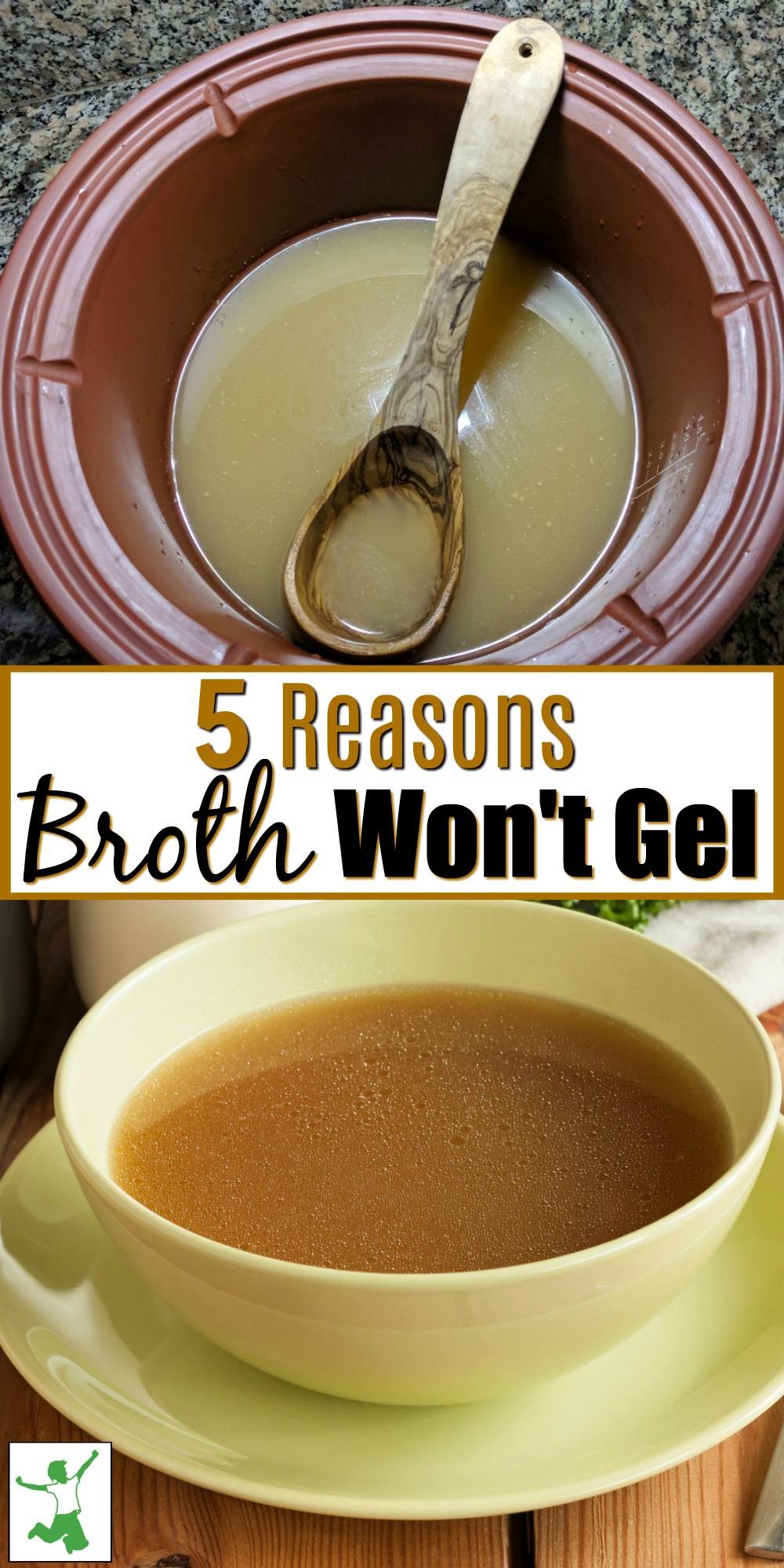
Do you have frequent trouble where your homemade broth doesn’t gel after being chilled in the refrigerator? This is a problem to solve quickly, as correct preparation is one of the foundational techniques of Traditional Cooking.
So critical is properly made, gelled homemade stock to the ongoing maintenance of health that Dr. Francis Pottenger MD, author of the nutrition classic Pottenger’s Cats, considered the stockpot the most important piece of equipment in the kitchen.
Homemade stock is so essential because it contains ample amounts of gelatin, a colloidal substance that attracts digestive juices to itself and prevents gastrointestinal bugs from attaching themselves to the gut wall and wreaking havoc. Natural gelatin both assists digestion and keeps you well!
In addition to gelatin, stock contains minerals such as calcium, silicon, sulphur, magnesium, phosphorus, and trace minerals all in a form that is incredibly easy for the body to absorb.
Do you take expensive supplements for joint pain or arthritis?
Simply adding homemade stock on a frequent basis to your diet will do your cartilage, tendons, and joints a world of good as stock also contains collagen, chondroitin sulfates, and glucosamine.
With homemade stock such a critical food to health, it is important to make it correctly. One sign that you have indeed performed the task well is that your stock gels beautifully once it is chilled in the refrigerator.
If you find that your stock won’t gel most of the time, here are the 5 typical reasons why as described by Monica Corrado, MA, CNC, and author of the blog Simply Being Well. Monica teaches cooking classes and does consultations, so be sure to check her website for this information if you could use some coaching.
Reasons Why Stock and Bone Broth Won’t Gel
- The stock rolled at too high a temperature. If stock or broth is simmered too high, the heat will break down and destroy the collagen. To see what the perfect simmer on your stock should look like, see my short video on the subject by clicking here.
- The stock did not roll long enough. Once you get that perfect simmer or “roll” going, be sure that chicken stock rolls for 6-24 hours and beef stock for 12-50 hours. Less than that will likely not draw enough gelatin into the stock from the bones.
- Not enough of the right kind of bones were used that yield gelatin. To get the right mix of bones that yield gelatin versus other types of bones that add flavor and color, make sure you use one of the following methods: 1 whole, free-range layer hen with neck and wings cut up, 3-4 lbs of boney chicken parts which includes a combo of necks, backs, and wings, OR the picked carcass of 2 meat chickens. For beef stock, use about 7 lbs bones total (4 lbs of boney bones and 3 lbs of meaty bones).
- Too much water was used in proportion to the bones. For chickens, the correct proportion is 3-4 lbs of bones per 4 quarts of filtered water. For beef stock, the correct proportion is 7 lbs of bones per 4 quarts of water or more to cover.
- Using bones from battery chickens or chickens raised in cages. Conventionally raised chickens or chickens raised in cages typically yield little to no gelatin. It is worth the extra money to get quality when you buy meat especially if you will be using those bones to make stock.
To get additional gelatin, add 2-4 chicken feet to the stockpot or even the head for even more! If your chicken is a rooster, add the comb. This will also add gelatin along with testosterone to the stock which adult men may find appealing as levels tend to decline with age.
Failsafe Solution If Your Stock Won’t Gel
If despite all your best efforts, you still come up with a pot of stock that does not gel, add 1 TBL of powdered gelatin per quart of liquid.
Vetted sources of good quality gelatin are available under the Supplements Section of my Shopping Guide.
Hopefully, these tips will help you solve the riddle of why your stock doesn’t gel so that the time you spend on this age-old culinary tradition is well spent producing the most nutrient-dense stock possible!

More Information about Gelatin
The Reason You Need More Gelatin in Your Diet
Gelatin and Collagen Hydrolysate: What’s the Difference?
The Benefits of Gelatin and How to Get More in Your Stock
Video: Stock that Gels!
More Information on Broth and Stock
How to Make Turkey Stock
The Healthiest and Best Bone Broth
How to Make Duck Stock
Rabbit Stock
How to Make Beef and Chicken Stock
How to Make Shrimp Stock
Confused about Stock versus Bone Broth?
The Perfect Simmer on Your Bone Broth








erjtweqtypaz
Hi Sarah,
I love, love love your blog! Quesion: once you’ve finished simmering a pot of beef broth, how long can it stay out to cool before going in the fridge? I forgot about mine yesterday and left it out for six hours before putting in the fridge. Is it still OK? Thanks for all you do and write!
In my house, I would consider that to be okay, and have used myself without any ill effect. Since the broth is going to be reheated anyway, that would take care of most nasties that might have found their way in.
Harold McGee (and Michael Ruhlman) would say no. After just a few hours at room temp, bacteria will begin to multiply and that they do rapidly. Unfortunately, boiling the stock doesn’t kill all the spores; there are apparently some kinds of spores that survive boiling.
I’m not willing to take that chance; it’s an inexpensive enough proposition to make your stock all over again. The only thing you lose is time.
Is the stock still nutritious if it hasn’t gelled?
Yes, it is.
Hi Mark, your marrow bones would be considered boney bones. Ox tail or beef shank would be meaty bones. Knuckle bones are usually boney bones as well. I have the butcher cut knuckle bones in smaller pieces so minerals can be released easier. You can roast the bones before making stock for a richer taste but I usually don’t take the time and still get a wonderful flavor. Simmer beef stock for at least 48 hours. Use only enough water to cover bones/meat/veggies. Adding some meaty bones will help add flavor as well. For chicken stock I use bones from chicken I have cooked for meals, store bought chicken backs and chicken feet. Adding the chicken feet to your beef stock should be just fine. I don’t get too concerned about following a specific recipe, only general guidelines. Good luck, stock is a great place to start!
Hello, what is meant be “boney bones or meaty bones” for item #3 for beef bones? Forgive me but this is the first time I’m trying to cook something other than a cheeseburger, hotdog, etc. I’m trying to get somewhat serious about healthy cooking. I recently bought 2 pounds of grass fed marrow beef bones which I’ve cooked for nearly 24 hours but the broth tastes like water so far. Are marrow bones considered boney, meaty, or otherwise? Is it ever advised to roast any of the bones before boiling them? Is it advised to include chicken feet in with beef bones or would that be a faux pas? I’ve heard that chicken feet have collagen; hence my contemplation of it. I have Crohn’s Disease which is why I’m seeking ways to heal my gut, thanks.
In the many recipes for stock that I’ve seen, raw bones are usually roasted first for better flavor in the stock. Cooked bones (from roasted chicken or cooked steak) can go directly into the pot – no need for further cooking.
Since it’s just my husband and me, and we eat more roasts than steaks, we don’t get a lot of beef bones to use. So I add whatever bones I have on hand (chicken, turkey, beef) to the stock. I don’t have enough freezer space to keep separate containers for each kind of bone or stock, so they get mixed into an “all meats” stock, and yes, I add chicken feet as well, even if it’s more beef bones than chicken.
Mine seems to be hit or miss on whether it gels. I can’t find perfectly raised chickens, so that’s probably why my chicken stock won’t gel. They are organic, but I can’t find free-range. 🙁 I’e got a great source for beef bones though! Making my first beef stock now!!
Even if my chicken and beef stock don’t gel, are they still nutritious?
I’m having a hard time finding bones but I just found a local wild game processor who will sell the bones. The problem is that they are considered dog bones and they don’t cut them very small and they don’t put them in the fridge. Is it safe to use the bones if they aren’t refrigerated?
Mine didn’t gel and I have no idea why. I sourced a knuckle (all grass fed of course) plenty of marrow and meaty bones, I wanna say 10lbs total. Apparently I forgot that I had started it a day sooner so in the end it was on the burner for about 76 hours. Pretty sure Fallon says up to 72 correct? I used 5 quarts of water but given that I had 10 lbs of bones that’s not far off from the 7 lbs/4 quarts ratio mentioned in this article. But here’s the kicker, the second night I scooped and strained a cup of it to make my porridge in the next morning and it gelled, so I thought I was successful. Finished up last night and this morning it’s just like the chicken stock that I can’t seem to get to gel either… did it just simmer too long? Oh also it definitely didn’t roll too high.
I make my broth with the perpetual soup method via http://nourishedkitchen.com/perpetual-soup-the-easiest-bone-broth-youll-make/
Does that method do anything to damage the gelatin? Am I still GETTING gelatin in my broth even if I don’t have enough bones per water ratio? Or am I only going to get gelatin benefits if it actually gels? Does that make sense? I use ACV and the bones for about a week. They completely soft when I’m done so I presume I get all the nutrients out. But is there anything about what I’m doing that breaks down the gelatin? I don’t want to be shooting myself in the foot thinking I’m getting nutrients when I’m not.
Oh, and I usually turn my crockpot on high til it boils, then all the way down to the lowest “keep warm” setting the entire rest of the time. It doesn’t simmer but definitely stays EXTREMELY hot. Thanks so much for any info you can give me!
Julia
thank you for this article!
I have been making bone-broth for just about a month, now. I drink a cup a day.. and started because/am hoping it will help a chronic, severe left-ankle tendon injury to heal—
I bought a 3.5 quart crockpot for the job (I live in a tiny NYC apartment!) and have been lucky every time with my chicken broth: it has gelled every time. I use ~1 lb of feet and necks + ~1 quart of filtered water.
but both times I tried making beef broth, it did not gel and I couldn’t figure out why.. your article explains it ! you recommend a ratio of 7 lbs of bones to only 4 quarts of water ! (for me, that means 1.5 lbs + 1 quart of water..) I used a 1.5 lb knuckle bone (24 oz) and added double that, in water: ~48-50 oz- way more than a quart. thank you!
I also was interested to read that you use the fat from the broth.. it has been drummed into me for so long that “fat is bad” that I haven’t done that. I’ve been throwing it away– maybe it’s time for me to experiment..
anyways, my cup of broth a day feels like a great, new habit. if it doesn’t help my tendon/ankle directly, I can’t help believe that it’s still doing me good!